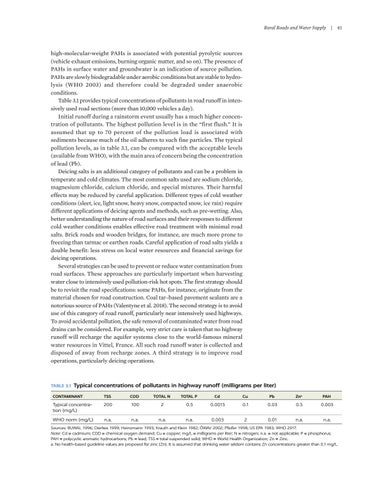Rural Roads and Water Supply | 41
high-molecular-weight PAHs is associated with potential pyrolytic sources (vehicle exhaust emissions, burning organic matter, and so on). The presence of PAHs in surface water and groundwater is an indication of source pollution. PAHs are slowly biodegradable under aerobic conditions but are stable to hydrolysis (WHO 2003) and therefore could be degraded under anaerobic conditions. Table 3.1 provides typical concentrations of pollutants in road runoff in intensively used road sections (more than 10,000 vehicles a day). Initial runoff during a rainstorm event usually has a much higher concentration of pollutants. The highest pollution level is in the “first flush.” It is assumed that up to 70 percent of the pollution load is associated with sediments because much of the oil adheres to such fine particles. The typical pollution levels, as in table 3.1, can be compared with the acceptable levels (available from WHO), with the main area of concern being the concentration of lead (Pb). Deicing salts is an additional category of pollutants and can be a problem in temperate and cold climates. The most common salts used are sodium chloride, magnesium chloride, calcium chloride, and special mixtures. Their harmful effects may be reduced by careful application. Different types of cold weather conditions (sleet, ice, light snow, heavy snow, compacted snow, ice rain) require different applications of deicing agents and methods, such as pre-wetting. Also, better understanding the nature of road surfaces and their responses to different cold weather conditions enables effective road treatment with minimal road salts. Brick roads and wooden bridges, for instance, are much more prone to freezing than tarmac or earthen roads. Careful application of road salts yields a double benefit: less stress on local water resources and financial savings for deicing operations. Several strategies can be used to prevent or reduce water contamination from road surfaces. These approaches are particularly important when harvesting water close to intensively used pollution-risk hot spots. The first strategy should be to revisit the road specifications: some PAHs, for instance, originate from the material chosen for road construction. Coal tar–based pavement sealants are a notorious source of PAHs (Valentyne et al. 2018). The second strategy is to avoid use of this category of road runoff, particularly near intensively used highways. To avoid accidental pollution, the safe removal of contaminated water from road drains can be considered. For example, very strict care is taken that no highway runoff will recharge the aquifer systems close to the world-famous mineral water resources in Vittel, France. All such road runoff water is collected and disposed of away from recharge zones. A third strategy is to improve road operations, particularly deicing operations.
TABLE 3.1 Typical
concentrations of pollutants in highway runoff (milligrams per liter)
CONTAMINANT
TSS
COD
TOTAL N
TOTAL P
Cd
Cu
Pb
Zna
PAH
Typical concentration (mg/L)
200
100
2
0.5
0.0015
0.1
0.03
0.5
0.003
WHO norm (mg/L)
n.a.
n.a.
n.a.
n.a.
0.003
2
0.01
n.a.
n.a.
Sources: BUWAL 1996; Dierkes 1999; Heinzmann 1993; Krauth and Klein 1982; ÖWAV 2002; Pfeifer 1998; US EPA 1983; WHO 2017. Note: Cd = cadmium; COD = chemical oxygen demand; Cu = copper; mg/L = milligrams per liter; N = nitrogen; n.a. = not applicable; P = phosphorus; PAH = polycyclic aromatic hydrocarbons; Pb = lead; TSS = total suspended solid; WHO = World Health Organization; Zn = Zinc. a. No health-based guideline values are proposed for zinc (Zn). It is assumed that drinking water seldom contains Zn concentrations greater than 0.1 mg/L.







































